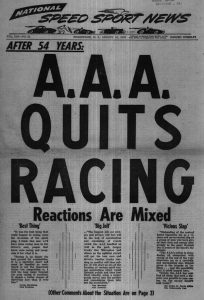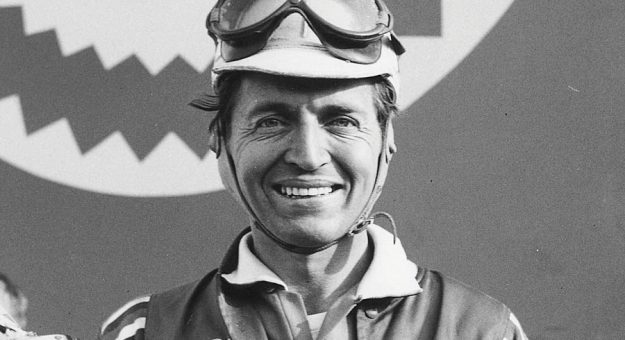Editor’s Note: NASCAR is celebrating its 75th anniversary in 2023. SPEED SPORT was founded in 1934 and was already on its way to becoming America’s Motorsports Authority when NASCAR was formed. As a result, we will bring you Part 8 of a 75-part series on the history of NASCAR as told in the pages of National Speed Sport News and SPEED SPORT Magazine.
Defending NASCAR Grand National champion Lee Petty picked up where he left off at the end of the 1954 season as he captured the first race of the 1955 season that was held on Nov. 7, 1954 in High Point, N.C.
Petty then maneuvered his Chrysler 300-B to early season trophies in Jacksonville Fla., and Savannah, Ga, en route to laurels in three of the first five events of the season.
This run made him a close second to one of the last Hudson Hornet pilots, 1953 champ Herb Thomas. Yet, like Thomas’ last season, Petty’s early surge failed to last and Tim Flock’s domination at the wheel of Carl Kiekhaefer’s Mercury Outboard Dealers’ Chrysler defined 1955.
Flock’s season began on an iconic note.
After disqualification from the previous season’s Daytona Beach, Fla., event for an altered carburetor cost him victory, Flock inherited the 1955 title after the NASCAR technical committee inspected first-place finisher Glenn “Fireball” Roberts’ Buick and ruled his engine was altered from factory-stock specifications.
Fellow driver Buck Baker explained in the March 2 issue of NSSN that the push rods of Fireball’s 1955 Buick Century were shortened in an attempt to increase its power. Despite debate about the effectiveness of such a tactic, Flock’s average speed of 92.056 mph became the new beach road course standard and he claimed victory in the first race of the season.
Good Press For NASCAR Turns Sour
Flock’s triumph became a sales victory for the companies associated with NASCAR. Chrysler launched a national advertising campaign touting Flock’s speed record, which included full-page color ads in magazines such as Newsweek, to expand its market share.
Also, the Champion Spark Plug Co. featured Petty, his wife Elizabeth and children Richard and Maurice in two-page magazine ads, which said Petty uses Champion on the track and in his family car. This advertising served to increase the public’s positive awareness of NASCAR.
The good press NASCAR and, by association, all of racing received after Speedweek disintegrated on June 12 in Le Mans, France. Two hours into the 39th annual 24-hour endure “a German Mercedes sports car hurtled off the track at 125 mph, exploded in the air and spread flaming death in a densely massed throng of onlookers,” stated the June 15 NSSN.
The article explained that the ill-fated Silver Arrow Mercedes, driven by France’s Pierre Levegh, smashed into the back of Lance Macklin’s Austin Healey and drove it into the pit wall. Levegh’s car then struck the wall, ricocheted across the track, catapulted a six-foot dirt wall and a picket fence and exploded.
The death toll was 79, later to rise to 82, with 91 people injured, in the worst racing-related accident in history.
AAA Withdraws From Racing
Two months after Le Mans, the American Automobile Assn’, the best recognized race sanctioning organization the United States, announced its withdrawal from racing. AAA President Andrw J. Sordoni cited the Le Mans tragedy and the “emphasis on speed, power and human endurance” in automobile racing.

AAA had confronted tragedy earlier in the year when two-time Indianapolis 500 winner Bill Vukovich was killed while leading the AAA-sanctioned classic.
Quoted in the Aug. 10 issue, Sordoni went on to explain that racing’s objectives were not compatible with its “day-to-day promotion of street and highway safety.”
Benny Kahn, sports editor of the Daytona Beach News-Journal, related AAA’s decision to NASCAR: “AAA withdrawing from racing leaves NASCAR practically alone in the driver’s seat in the stock car field…The stage is now set for a blood transfusion in automobile racing. It may come from energetic Bill France, who has built the world’s largest stock car racing organization in 8 years.”
The expansion of France’s organization continued with the start of construction on Daytona Int’l Speedway on land adjacent to Daytona Beach Municipal Airport.
Plans for the 2.5-mile triangular track called for three straights and three turns wider and higher than any other track in existence. Grandstands were to seat 30,000 spectators and the infield was designed to allow 50,000 more to view the races.
With financing in place, the superspeedway was scheduled to open on July 4, 1956, with a 300-mile race, according to the June 15 edition of NSSN, but did not host a race until the inaugural Daytona 500 on Feb. 22, 1959.
On the track in 1955, Tim Flock missed victory lane in the four post-Daytona Beach races despite starting on the pole twice. Flock’s late start and lone victory kept him out of the top 10 in the point standings until April when he entered at ninth, far behind leader Petty.
Yet, with 36 races remaining on the 45-race calendar, Flock began an amazing run of 17 victories and 15 poles, including a pole-to-checkers run at Hillsboro, N.C., which clinched the points title over Baker. Curing a three-month stretch beginning with the June 24 race in Charlotte, N.C., and ending with the Sept. 18 event at Langhorne (Pa.) Speedway, Flock captured 11 of 15 poles and won eight races.
Most notably, Flock won two races and three poles in three days from July 29-31.
Team Tactics Come Into Play
Key to Flock’s success was the Mercury Outboard magnate, Carl Kiekhaefer. The first multi-car owner in NASCAR history, Kiekhaefer provided Chrysler 300s for Tim and Fonty Flock and Al “Speedy” Thompson. Instead of towing or event driving their race car to races, these three drivers simply arrived at the track in time to qualify as their cars were hauled by truck to each track.
With teammates came the teamwork which helped Flock earn his second championship.
In the Lehi, Ark., race on Aug. 15, Fonty pushed Tim into the pits to refuel which enabled him to take third rather than drop out of the race. Tim won the decisive last race of the season in a Kiekhaefer car designated for Fonty, after his vehicle failed to arrive in time for qualifying.
The Mercury Outboard Motors team’s 23 victories gave Chrysler the manufacturers’ championship, Kiekhaefer the owner’s title and inspired Ford and Chevrolet to set up factory teams.
The auto manufacturers’ direct involvement in NASCAR altered the sanctioning body’s strictly stock policy.
Don O’Reilly, NASCAR’s News Bureau Director, reported in his Nov. 30 NSSN column that France in a meeting with the Automobile Manufacturers’ Ass’n in Detroit, said there was a time when the racing associations could use the specifications or the factory parts books as the guide for racing rules, but the increased factory participation in the sport made that impractical now.
Instead, France added, NASCAR would establish its own specifications. This statement U-bolted the door closed on strictly stock cars and opened the hood for chances to the specifications. In NASCAR’s other divisions, Fred Meeker won the midget crown and Bill Meyers was the sportsman champ.
Bill Widenhouse became the modified season champion and Jim Reed won the short track late model title.
Fred Pfisterer took home the sportscar prize and Roger Bailey won the Ford midget championship.
